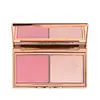L'Oreal True Match Super-Blendable Blush Versus Charlotte Tilbury Hollywood Blush & Glow Glide Palette
What's inside
What's inside
 Key Ingredients
Key Ingredients

 Benefits
Benefits

No benefits
 Concerns
Concerns

 Ingredients Side-by-side
Ingredients Side-by-side

Talc
AbrasiveDimethicone
EmollientNylon-12
Polymethylsilsesquioxane
Magnesium Stearate
Cosmetic ColorantCetyl Dimethicone
EmollientTrimethylsiloxysilicate
EmollientCaprylyl Glycol
EmollientSilica
AbrasiveMica
Cosmetic ColorantCI 77891
Cosmetic ColorantCI 77491
Cosmetic ColorantCI 77492
Cosmetic ColorantCI 77499
Cosmetic ColorantCI 75470
Cosmetic ColorantCI 77007
Cosmetic ColorantCI 73360
Cosmetic ColorantTalc
AbrasiveOryza Sativa Starch
AbsorbentMica
Cosmetic ColorantDimethicone
EmollientOctyldodecyl Stearoyl Stearate
EmollientAluminum Hydroxide
EmollientZinc Stearate
Cosmetic ColorantCaprylyl Glycol
EmollientPhenoxyethanol
PreservativeDimethiconol
EmollientHexylene Glycol
EmulsifyingIsononyl Isononanoate
EmollientDimethicone/Vinyl Dimethicone Crosspolymer
Skin ConditioningPolymethylsilsesquioxane
Silica
AbrasiveTrimethylsiloxysilicate
EmollientCI 77891
Cosmetic ColorantIron Oxides
CI 19140
Cosmetic ColorantCI 15985
Cosmetic ColorantCI 15850
Cosmetic ColorantCI 73360
Cosmetic ColorantSqualane
EmollientDiisostearyl Malate
EmollientBoron Nitride
AbsorbentHdi/Trimethylol Hexyllactone Crosspolymer
Zea Mays Starch
AbsorbentEthylhexylglycerin
Skin ConditioningMaltodextrin
AbsorbentTin Oxide
AbrasiveCI 75470
Cosmetic ColorantTalc, Oryza Sativa Starch, Mica, Dimethicone, Octyldodecyl Stearoyl Stearate, Aluminum Hydroxide, Zinc Stearate, Caprylyl Glycol, Phenoxyethanol, Dimethiconol, Hexylene Glycol, Isononyl Isononanoate, Dimethicone/Vinyl Dimethicone Crosspolymer, Polymethylsilsesquioxane, Silica, Trimethylsiloxysilicate, CI 77891, Iron Oxides, CI 19140, CI 15985, CI 15850, CI 73360, Squalane, Diisostearyl Malate, Boron Nitride, Hdi/Trimethylol Hexyllactone Crosspolymer, Zea Mays Starch, Ethylhexylglycerin, Maltodextrin, Tin Oxide, CI 75470
Ingredients Explained
These ingredients are found in both products.
Ingredients higher up in an ingredient list are typically present in a larger amount.
Caprylyl Glycol is a humectant and emollient, meaning it attracts and preserves moisture.
It is a common ingredient in many products, especially those designed to hydrate skin. The primary benefits are retaining moisture, skin softening, and promoting a healthy skin barrier.
Though Caprylyl Glycol is an alcohol derived from fatty acids, it is not the kind that can dry out skin.
This ingredient is also used as a preservative to extend the life of products. It has slight antimicrobial properties.
Learn more about Caprylyl GlycolCi 73360 is a synthetic red-pink dye.
Ci 75470 is a bright-red pigment. It is AKA carmine.
Carmine is derived from insects such as the cochineal beetle. This ingredient has been used as a natural dye for over 2000 years.
Ci 77891 is a white pigment from Titanium dioxide. It is naturally found in minerals such as rutile and ilmenite.
It's main function is to add a white color to cosmetics. It can also be mixed with other colors to create different shades.
Ci 77891 is commonly found in sunscreens due to its ability to block UV rays.
Learn more about CI 77891Dimethicone is a type of synthetic silicone created from natural materials such as quartz.
What it does:
Dimethicone comes in different viscosities:
Depending on the viscosity, dimethicone has different properties.
Ingredients lists don't always show which type is used, so we recommend reaching out to the brand if you have questions about the viscosity.
This ingredient is unlikely to cause irritation because it does not get absorbed into skin. However, people with silicone allergies should be careful about using this ingredient.
Note: Dimethicone may contribute to pilling. This is because it is not oil or water soluble, so pilling may occur when layered with products. When mixed with heavy oils in a formula, the outcome is also quite greasy.
Learn more about DimethiconeMica is a naturally occurring mineral used to add shimmer and color in cosmetics. It can also help improve the texture of a product or give it an opaque, white/silver color.
Serecite is the name for very fine but ragged grains of mica.
This ingredient is often coated with metal oxides like titanium dioxide. Trace amounts of heavy metals may be found in mica, but these metals are not harmful in our personal products.
Mica has been used since prehistoric times throughout the world. Ancient Egyptian, Indian, Greek, Roman, Aztec, and Chinese civilizations have used mica.
Learn more about MicaPolymethylsilsesquioxane is a silicone used as a film forming agent.
When applied to the skin, this ingredient creates an invisible film on the surface. This film still allows oxygen to pass through, but prevents moisture from escaping. This can help condition and hydrate the skin. It also leaves a silky feel when applied.
Polymethylsilsesquioxane has not been shown to clog pores. It has been deemed safe to use up to 55%, but most cosmetics use much less.
If you have concerns about using this ingredient, we recommend speaking with a professional.
Learn more about PolymethylsilsesquioxaneSilica, also known as silicon dioxide, is a naturally occurring mineral. It is used as a fine, spherical, and porous powder in cosmetics.
Though it has exfoliant properties, the function of silica varies depending on the product.
The unique structure of silica enhances the spreadability and adds smoothness, making it a great texture enhancer.
It is also used as an active carrier, emulsifier, and mattifier due to its ability to absorb excess oil.
In some products, tiny microneedles called spicules are made from silica or hydrolyzed sponge. When you rub them in, they lightly polish away dead skin layers and enhance the penetration of active ingredients.
Learn more about SilicaTalc is a clay mineral. It helps absorb moisture and improve the texture of products. Like other types of clay, Talc can have a slight exfoliating effect on skin. Talc can be added to increase the volume of products.
Some Baby powders are made by combining talc with corn starch. The word "talc" comes from Latin and originates from Arabic. Talc is a mineral commonly found throughout the world.
If you have any concerns about using talc, we recommend checking out the FDA's official page.
Learn more about TalcThis silicone is an emollient. Emollients create a thin film on the skin to prevent moisture from escaping.
It is not soluble in water and helps increase water-resistance in products.
According to a manufacturer, it can blend seamlessly with silicone oils, such as Cyclopentasiloxane.
Learn more about Trimethylsiloxysilicate